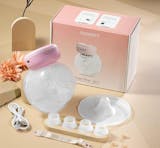Returning to Work: Creating a Breast Pumping Plan

Returning to work while continuing to breastfeed represents a significant transition for many mothers. With preparation, communication, and the right resources, you can successfully maintain your breastfeeding relationship while managing professional responsibilities. This comprehensive guide will help you develop a personalized pumping plan that works for both your career and your breastfeeding goals.
Planning Ahead: Before Your Return
Timing Your Return Strategically
If possible, consider these timing factors:
- Gradual return: Part-time or shorter days initially
- Mid-week start: Beginning on Wednesday/Thursday creates a shorter first week
- Milk supply establishment: Returning after supply is well-established (typically 4-6 weeks postpartum)
- Trial run: Practice your routine before official return date
Understanding Your Legal Rights
In the United States:
- Federal protections: The Break Time for Nursing Mothers law requires employers to provide reasonable break time and a private space (not a bathroom) for hourly employees to express milk for one year after birth
- State laws: Many states have additional protections that may include salaried employees or longer durations
- PUMP for Nursing Mothers Act (2023): Expanded federal protections to more employees
Research specific protections in your location and understand how they apply to your situation.
Building a Freezer Stash
Begin collecting milk 3-4 weeks before returning to work:
- Start small: Pump once daily, usually in the morning after first feeding
- Store in small quantities: 2-3 oz portions minimize waste
- Goal setting: Aim for 1-1.5 times your baby's typical daily intake
- Avoid oversupply: Don't pump excessively as it can lead to engorgement and other issues
Bottle Introduction
Introduce bottle-feeding 2-3 weeks before returning to work:
- Wait until breastfeeding is well-established: Usually 3-4 weeks postpartum
- Have someone else offer the bottle: Babies often associate mothers with direct nursing
- Use slow-flow nipples: These most closely mimic breastfeeding pace
- Try different bottles: Some babies have preferences
- Practice paced bottle feeding: This technique prevents overfeeding and mimics breastfeeding rhythm
Equipment Preparation
Essential pumping supplies:
- Double electric breast pump (hospital-grade if possible)
- Extra pump parts (membranes, valves, flanges)
- Properly sized flanges for comfort and efficiency
- Milk storage containers (bottles or bags)
- Cooler with ice packs
- Cleaning supplies (wipes, microwave sterilization bags)
- Hands-free pumping bra
- Photo of your baby (helps with let-down)
Consider investing in:
- Second pump to leave at workplace
- Car adapter for commute pumping
- Wearable pump for flexibility
- Extra sets of pump parts to reduce washing
Communicating with Your Employer
Initial Conversations
Ideally, discuss your pumping needs before maternity leave:
- Be direct and specific: "I'll need to pump approximately X times during the workday"
- Focus on solutions: "I've thought about how to minimize disruption to workflow"
- Emphasize benefits: Less time off for sick baby, quicker return to work, etc.
- Know your rights: Approach conversation with confidence based on legal protections
Creating a Written Plan
Provide a written pumping plan to supervisor/HR including:
- Frequency and duration: Typical pumping schedule
- Space needs: Requirements for private, clean space
- Storage needs: Refrigeration access for milk
- Coverage plan: How your work will be handled during pumping breaks
- Communication protocol: How to reach you during pumping sessions if urgent
- Flexibility statement: Acknowledgment that adjustments may be needed
Addressing Potential Pushback
If you encounter resistance:
- Educate: Share information about breast milk benefits and legal requirements
- Problem-solve: Offer creative solutions for space or scheduling challenges
- Involve HR: Seek support from human resources if direct supervisor is resistant
- Document: Keep records of conversations about accommodations
- Connect with others: Find colleagues who have successfully pumped at work
Creating Your Pumping Schedule
Determining Frequency
For exclusively breastfed babies:
- Babies under 6 months: Typically need pumping every 3 hours (approximately 3 times in 8-hour workday)
- Babies 6+ months with solids: May need pumping every 4 hours (approximately 2 times in 8-hour workday)
- Note: Individual needs vary based on storage capacity and supply
Sample Schedules
Standard 9-5 Schedule (Baby Under 6 Months):
- 6:00 AM: Nurse baby before leaving home
- 9:00 AM: First pumping session at work
- 12:00 PM: Second pumping session (lunch break)
- 3:00 PM: Third pumping session
- 5:30 PM: Nurse baby upon reunion
Extended Day Schedule:
- 6:00 AM: Nurse baby before leaving
- 8:30 AM: First pumping session
- 11:30 AM: Second pumping session
- 2:30 PM: Third pumping session
- 5:30 PM: Fourth pumping session (if needed)
- 7:00 PM: Nurse baby upon reunion
Part-Time Schedule:
- 7:00 AM: Nurse baby before leaving
- 10:00 AM: Pumping session
- 1:00 PM: Return home and nurse
Maximizing Efficiency
Streamline your routine:
- Pump kit preparation: Assemble parts before work day
- Hands-free setup: Use hands-free bra to multitask
- Multi-tasking options: Handle emails, phone calls, or simple tasks
- Set calendar reminders: Block pumping time on work calendar
- Standardize routine: Create checklist for gathering supplies, cleaning, storing
Setting Up Your Workplace Pumping Space
Dedicated Lactation Room Essentials
If your workplace has a lactation room, it should include:
- Privacy: Locking door and window coverings
- Comfort: Chair with back support
- Electrical outlet: For pump operation
- Surface space: Clean area for pump and supplies
- Sink access: For washing hands and pump parts (ideally in room)
- Refrigeration: For milk storage (dedicated or shared)
Creating a Makeshift Space
If no dedicated space exists:
- Private office: Add door sign and window covering
- Conference room: Schedule regular blocks with "meeting" title
- Storage room: Ensure cleanliness and add chair
- Wellness room: Coordinate scheduling with others
- Car adaptation: As last resort with window coverings and inverter for pump
Essential Supplies to Keep at Work
Maintain a work pumping kit with:
- Pump and parts: Main components and spares
- Cleaning supplies: Wipes, soap, brush, sterilizer bags
- Milk storage containers: Bottles or bags
- Personal comfort items: Nursing pads, extra shirt, water bottle
- Hands-free necessities: Pumping bra or clips
- Documentation: Copies of relevant workplace policies or laws
- "Do Not Disturb" sign: Clear door signage
- Cooler and ice packs: For transport home
Milk Storage and Transport
Daily Transport System
Establish a reliable system for bringing milk home:
- Insulated cooler bag: With sufficient ice packs
- Leak-proof containers: Secure all lids and closures
- Temperature monitoring: Consider thermometer for long commutes
- Vehicle placement: Away from direct sun/heat
Workplace Storage Options
Options for milk storage during workday:
- Dedicated refrigerator: Ideal for lactation rooms
- Shared refrigerator: Use opaque bag for privacy
- Personal cooler: Refresh ice as needed
- Milk shipping: For travel or extended separation
Handling Expressed Milk
- Proper labeling: Date, time, and volume
- Combining milk: Cool freshly expressed milk before adding to already refrigerated milk
- Storage guidelines: Follow recommended time frames (see CDC or Academy of Breastfeeding Medicine)
- Childcare instructions: Provide clear guidance on handling and feeding
Managing Common Challenges
Supply Maintenance
Strategies to maintain supply while working:
- Morning nursing: Nurse baby before leaving for work
- Consistent emptying: Regular and complete breast drainage
- Breast compression: During pumping to improve output
- Power pumping: Occasional sessions to boost supply (pump 20 min, rest 10 min, pump 10 min, rest 10 min, pump 10 min)
- Stay hydrated and nourished: Prioritize fluid intake and adequate calories
- Skin-to-skin time: Maximize when together with baby
Dealing with Pumping Obstacles
Solutions for common work pumping challenges:
- Forgotten parts: Keep spare set at work
- Milk storage emergencies: Know guidelines for short-term room temperature storage
- Schedule interruptions: Communicate importance and reschedule promptly
- Supply drops: Temporary increase in pumping frequency
- Pump malfunction: Have manual pump as backup
- Travel requirements: Research facilities and plan ahead
Managing Work Relationships
Navigating interpersonal dynamics:
- Setting boundaries: Clear communication about pumping needs
- Educating colleagues: Brief, matter-of-fact explanations if needed
- Finding allies: Connect with other pumping parents
- Handling comments: Prepared responses for inappropriate remarks
- Addressing resentment: Focus on work completion, not time away
Special Situations
Business Travel
Preparation for work trips:
- Research accommodations: Ensure refrigeration access
- Transportation plan: Security protocols for airports/trains
- Shipping options: Services like Milk Stork for sending milk home
- Pump adapters: International voltage converters if needed
- Storage solutions: Hotel arrangements for refrigeration
- Schedule accommodation: Build in pumping time between meetings
Extended Workdays
Strategies for long shifts:
- Wearable options: Consider pumps that allow continued work
- Strategic scheduling: Plan meetings around pumping needs
- Efficiency focus: Maximize output during available breaks
- Supply protection: Avoid extending time between sessions beyond 4-5 hours
- Partner coordination: Arrange direct nursing before/after extended days
Shift Work Adaptations
For overnight or variable shifts:
- Maintain regularity: Pump at similar intervals regardless of shift
- Gradual transition: Adjust schedule slowly for changing shifts
- Sleep considerations: Prioritize pumping and rest during critical supply periods
- Reverse cycling: Some babies adapt by nursing more when parent is home
Maintaining Balance and Self-Care
Setting Realistic Expectations
- Acknowledge challenges: Working and pumping is demanding
- Define success personally: What constitutes "enough" milk production
- Reassess regularly: Adjust plan based on evolving needs
- Consider supplementation: Partial breastfeeding is valuable too
- Be flexible: Adapt as baby grows and work demands change
Supporting Your Wellbeing
Essential self-care while pumping at work:
- Nutritional support: Easy-to-eat, nutritious snacks
- Hydration stations: Water bottles throughout workplace
- Stress management: Brief relaxation during pumping sessions
- Connection moments: Photos or videos of baby during pumping
- Community building: Connect with other pumping parents
Celebrating Milestones
Acknowledge your accomplishments:
- Track progress: Note days, weeks, months of providing milk
- Appreciate dual roles: Recognize the challenge of balancing work and pumping
- Document journey: Photos or journal entries about experience
- Share wisdom: Mentor other returning parents when ready
Gradual Weaning from Pumping
Transitioning Strategies
When ready to reduce or end pumping at work:
- Gradual reduction: Drop one pumping session at a time
- Session shortening: Reduce duration before eliminating
- Spacing changes: Gradually increase time between sessions
- Strategic timing: Start with midday session, maintain morning session longest
- Monitor comfort: Express just enough to relieve pressure when extending times
Continuing Your Breastfeeding Relationship
Many mothers continue nursing while reducing pumping:
- Weekend and evening nursing: Maintain supply for non-work hours
- Partial breastfeeding: Combine with formula or solid foods as appropriate
- Extended relationship: Direct nursing can continue long after pumping ends
Final Thoughts
Returning to work while continuing to provide breast milk is a significant accomplishment that requires planning, dedication, and support. By creating a comprehensive pumping plan, communicating effectively with your employer, and preparing both physically and mentally for this transition, you can successfully navigate this phase of your breastfeeding journey.
Remember that any amount of breast milk you provide offers benefits to your baby, and finding a balance that works for your family is the ultimate goal. With preparation and persistence, many mothers successfully combine breastfeeding with their professional lives for as long as they choose.


